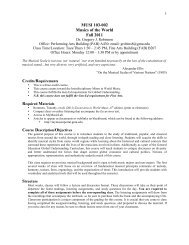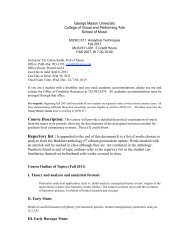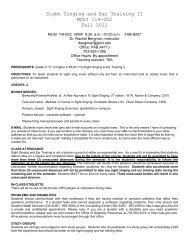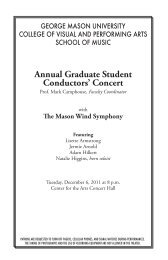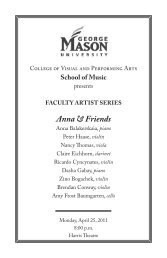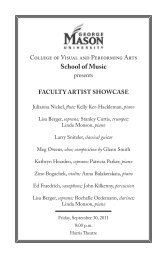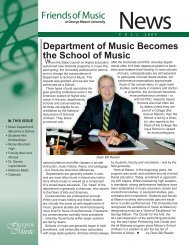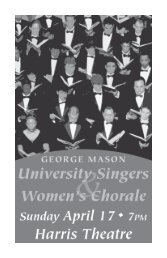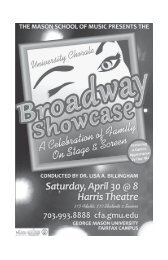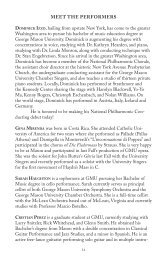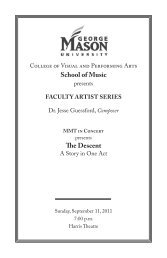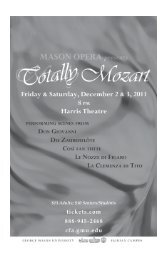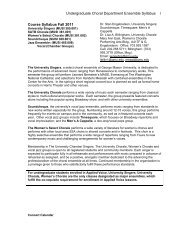complete recital program - George Mason University School of Music
complete recital program - George Mason University School of Music
complete recital program - George Mason University School of Music
You also want an ePaper? Increase the reach of your titles
YUMPU automatically turns print PDFs into web optimized ePapers that Google loves.
Huffman maintained a close pr<strong>of</strong>essional relationship with oboist,<br />
John de Lancie. This included collaborations on this concerto with<br />
“Pershing’s Own” in the years before Mr. de Lancie’s passing. The Strauss<br />
oboe concerto is unique among compositions in that the story behind<br />
it can be directly traced. This story is even more remarkable when one<br />
learns <strong>of</strong> the amazing coincidences that led up to its creation.<br />
In the mid 1930s, a young oboist (age 15) was accepted into the<br />
prestigious Curtis Institute <strong>of</strong> <strong>Music</strong> in Philadelphia. He would study<br />
with the legendary oboist Marcel Tabuteau. Graduating at age 18, John de<br />
Lancie was named principal oboist <strong>of</strong> the Pittsburgh Symphony (under<br />
the renowned Strauss expert, Fritz Reiner). As World War II began, de<br />
Lancie enlisted in the United States Army Band (now, Pershing’s Own)<br />
in Washington DC. The Army Band was deployed to North Africa and<br />
spent nine months in Algiers (a French speaking colony). This <strong>of</strong>fered de<br />
Lancie an opportunity to learn French fluently. When the band deployed<br />
to the United Kingdom, de Lancie was asked to join the OSS (a precursor<br />
to the CIA). The OSS was urgently seeking Americans who spoke French.<br />
Shipped <strong>of</strong>f to France, de Lancie used his French to expose spies<br />
radio-ing American troop movements back to Germany. At the conclusion<br />
<strong>of</strong> the war he was sent to Germany himself to search for the handlers<br />
<strong>of</strong> those French spies. It was in Garmisch-Partenkirschen that de<br />
Lancie ran into his old friend from The Curtis Institute, Alfred Mann.<br />
Since, Reiner had communicated such an appreciation for Strauss, de<br />
Lancie was excited by the possibility <strong>of</strong> meeting Strauss in person. To this<br />
Alfred replied that the Strauss villa was just up the street. Alfred and de<br />
Lancie spent three days with Strauss. Strauss spoke French quite well, so<br />
they all had no trouble communicating.<br />
At one point, de Lancie asked Strauss if he had ever considered<br />
writing an oboe concerto (since he seemed to have a special affinity for<br />
the oboe, writing such beautiful oboe solos in Don Juan and Death and<br />
Transfiguration). Strauss replied simply: “no”, and was the end <strong>of</strong> the matter,<br />
or so it seemed. It was the end <strong>of</strong> WW II, and even though Strauss’<br />
association with the Nazi party had been nominal (at most) he still had<br />
to be cleared <strong>of</strong> enemy suspicion. Waiting around his villa – he decided<br />
to use this otherwise idle time to put pen to paper, one month later, the<br />
Strauss Oboe Concerto was finished.<br />
9



